Abstract
Aryl hydrocarbon hydroxylase is present and is inducible in mouse skin. 7,8-Benzoflavone, an inhibitor of the enzyme, markedly inhibits tumorigenesis by 7,12-dimethylbenz(a)anthracene, but has either no effect on or stimulates benzo(a)pyrene tumorigenesis. Thus, the role of aryl hydrocarbon hydroxylase appears highly specific for each polycyclic hydrocarbon, in respect to detoxification and/or activation of the hydrocarbon to a carcinogenic form. In parallel studies, we found that 7,8-benzoflavone significantly reduces the amount of 7,12-dimethylbenz(a)anthracene binding to mouse skin DNA, RNA, and protein, and the binding of benzo(a)pyrene to RNA and protein of mouse skin. 7,8-Benzoflavone exhibited a markedly lesser effect on the binding of benzo(a)pyrene to DNA.
Keywords: benzo(a)pyrene; 7,12-dimethylbenz(a)anthracene; DNA, RNA, and protein binding; mouse skin
Full text
PDF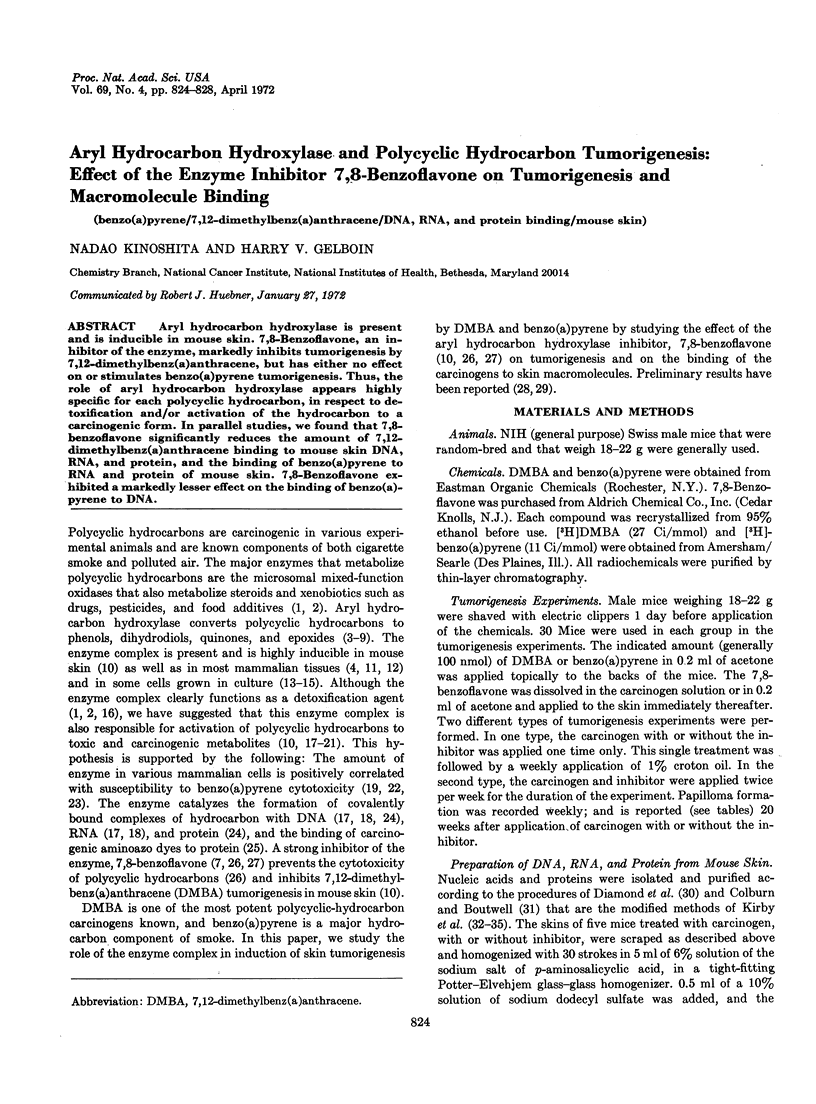
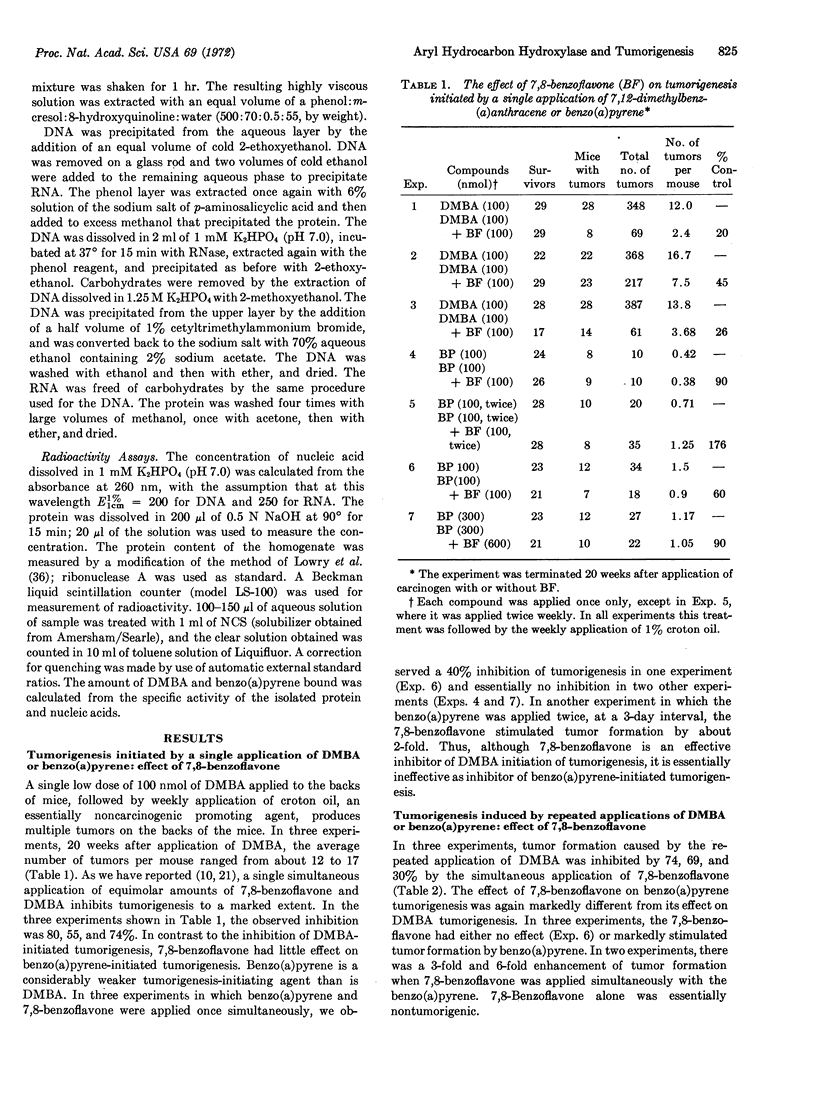
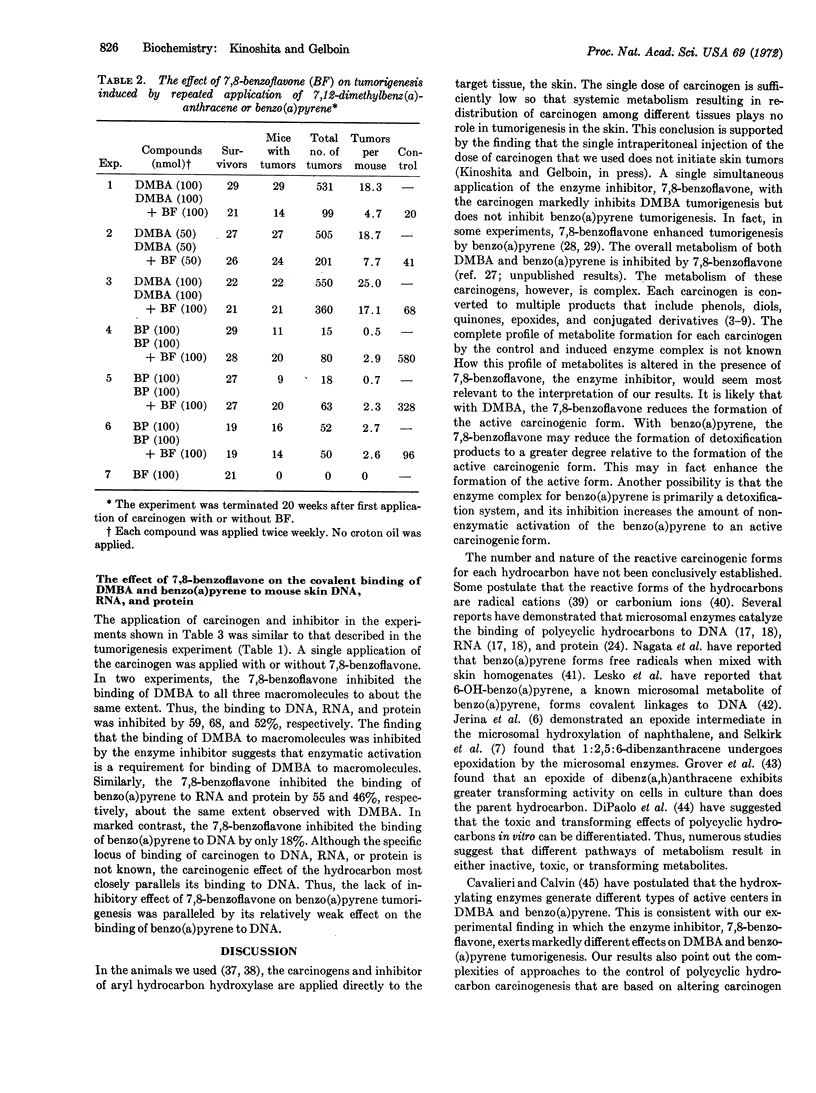
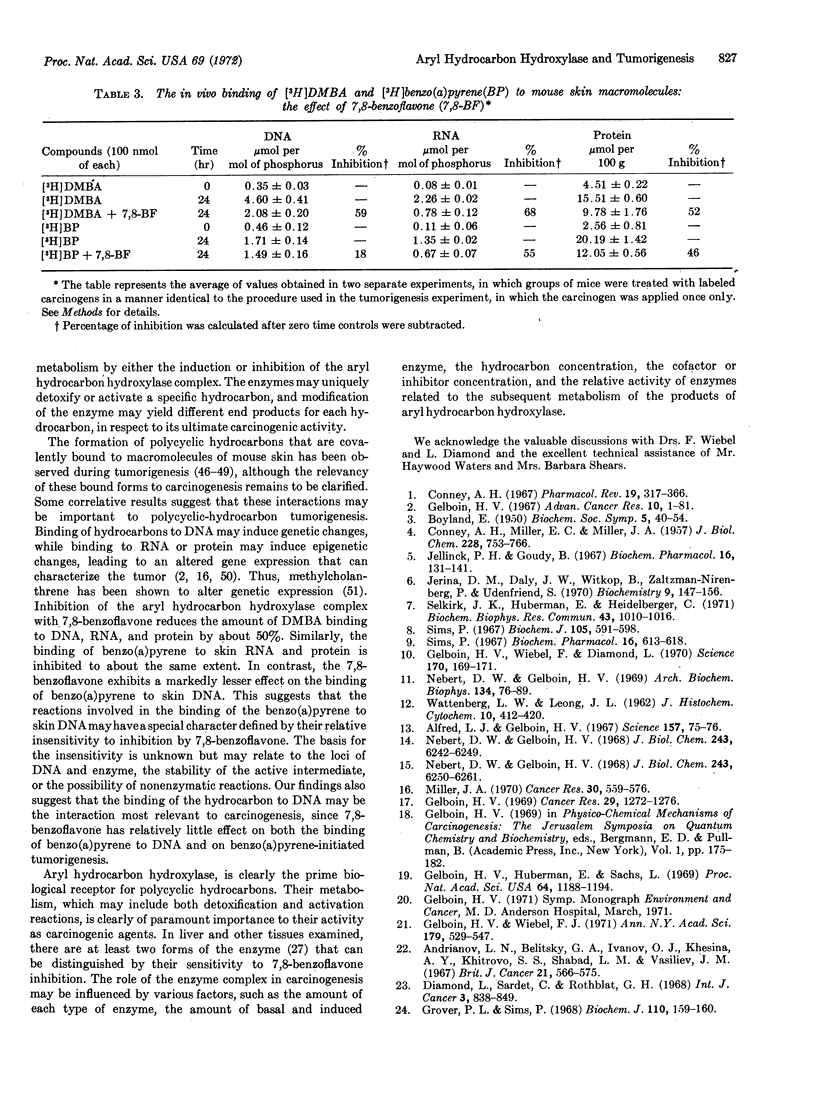
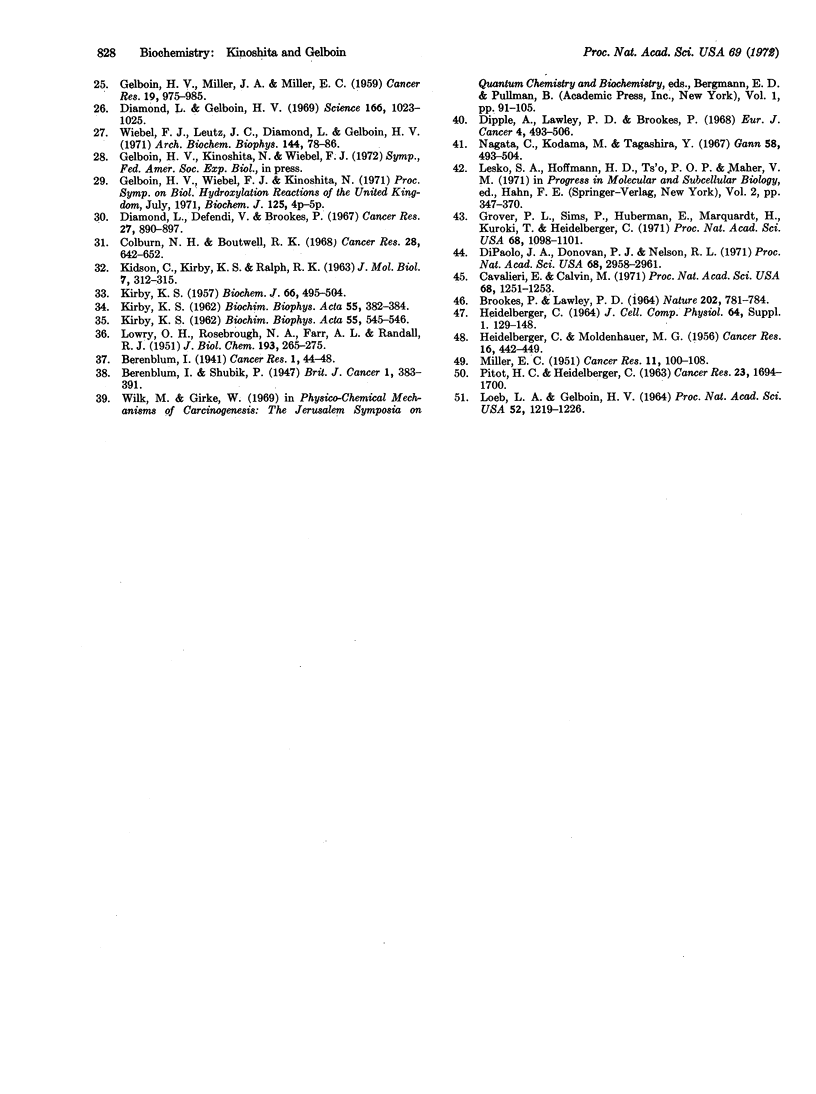
Selected References
These references are in PubMed. This may not be the complete list of references from this article.
- Alfred L. J., Gelboin H. V. Benzpyrene hydroxylase induction by polycyclic hydrocarbons in hamster embryonic cells grown in vitro. Science. 1967 Jul 7;157(3784):75–76. doi: 10.1126/science.157.3784.75. [DOI] [PubMed] [Google Scholar]
- Andrianov L. N., Belitsky G. A., Ivanova O. J., Khesina A. Y., Khitrovo S. S., Shabad L. M., Vasiliev J. M. Metabolic degradation of 3,4-benzopyrene in the cultures of normal and neoplastic fibroblasts. Br J Cancer. 1967 Sep;21(3):566–575. doi: 10.1038/bjc.1967.66. [DOI] [PMC free article] [PubMed] [Google Scholar]
- BROOKES P., LAWLEY P. D. EVIDENCE FOR THE BINDING OF POLYNUCLEAR AROMATIC HYDROCARBONS TO THE NUCLEIC ACIDS OF MOUSE SKIN: RELATION BETWEEN CARCINOGENIC POWER OF HYDROCARBONS AND THEIR BINDING TO DEOXYRIBONUCLEIC ACID. Nature. 1964 May 23;202:781–784. doi: 10.1038/202781a0. [DOI] [PubMed] [Google Scholar]
- CONNEY A. H., MILLER E. C., MILLER J. A. Substrate-induced synthesis and other properties of benzpyrene hydroxylase in rat liver. J Biol Chem. 1957 Oct;228(2):753–766. [PubMed] [Google Scholar]
- Cavalieri E., Calvin M. Molecular characteristics of some carcinogenic hydrocarbons. Proc Natl Acad Sci U S A. 1971 Jun;68(6):1251–1253. doi: 10.1073/pnas.68.6.1251. [DOI] [PMC free article] [PubMed] [Google Scholar]
- Colburn N. H., Boutwell R. K. The in vivo binding of beta-propiolactone to mouse skin DNA, RNA, and protein. Cancer Res. 1968 Apr;28(4):642–652. [PubMed] [Google Scholar]
- Conney A. H. Pharmacological implications of microsomal enzyme induction. Pharmacol Rev. 1967 Sep;19(3):317–366. [PubMed] [Google Scholar]
- Diamond L., Defendi V., Brookes P. The interaction of 7,12-dimethylbenz(a)anthracene with cells sensitive and resistant to toxicity induced by this carcinogen. Cancer Res. 1967 May;27(5):890–897. [PubMed] [Google Scholar]
- Diamond L., Gelboin H. V. Alpha-naphthoflavone: an inhibitor of hydrocarbon cytotoxicity and microsomal hydroxylase. Science. 1969 Nov 21;166(3908):1023–1025. doi: 10.1126/science.166.3908.1023. [DOI] [PubMed] [Google Scholar]
- Diamond L., Sardet C., Rothblat G. H. The metabolism of 7,12-dimethylbenz(a)anthracene in cell cultures. Int J Cancer. 1968 Nov 15;3(6):838–849. doi: 10.1002/ijc.2910030617. [DOI] [PubMed] [Google Scholar]
- Dipaolo J. A., Donovan P. J., Nelson R. L. Transformation of hamster cells in vitro by polycyclic hydrocarbons without cytotoxicity. Proc Natl Acad Sci U S A. 1971 Dec;68(12):2958–2961. doi: 10.1073/pnas.68.12.2958. [DOI] [PMC free article] [PubMed] [Google Scholar]
- Dipple A., Lawley P. D., Brookes P. Theory of tumour initiation by chemical carcinogens: dependence of activity on structure of ultimate carcinogen. Eur J Cancer. 1968 Oct;4(5):493–506. doi: 10.1016/0014-2964(68)90005-4. [DOI] [PubMed] [Google Scholar]
- GELBOIN H. V., MILLER J. A., MILLER E. C. The in vitro formation of protein-bound derivatives of aminoazo dyes by rat liver preparations. Cancer Res. 1959 Oct;19:975–985. [PubMed] [Google Scholar]
- Gelboin H. V. A microsome-dependent binding of benzo[a]pyrene to DNA. Cancer Res. 1969 Jun;29(6):1272–1276. [PubMed] [Google Scholar]
- Gelboin H. V. Carcinogens, enzyme induction, and gene action. Adv Cancer Res. 1967;10:1–81. doi: 10.1016/s0065-230x(08)60076-7. [DOI] [PubMed] [Google Scholar]
- Gelboin H. V., Huberman E., Sachs L. Enzymatic hydroxylation of benzopyrene and its relationship to cytotoxicity. Proc Natl Acad Sci U S A. 1969 Dec;64(4):1188–1194. doi: 10.1073/pnas.64.4.1188. [DOI] [PMC free article] [PubMed] [Google Scholar]
- Gelboin H. V., Wiebel F., Diamond L. Dimethylbenzanthracene tumorigenesis and aryl hydrocarbon hydroxylase in mouse skin: inhibition by 7,8-benzoflavone. Science. 1970 Oct 9;170(3954):169–171. doi: 10.1126/science.170.3954.169. [DOI] [PubMed] [Google Scholar]
- Grover P. L., Sims P. Enzyme-catalysed reactions of polycyclic hydrocarbons with deoxyribonucleic acid and protein in vitro. Biochem J. 1968 Nov;110(1):159–160. doi: 10.1042/bj1100159. [DOI] [PMC free article] [PubMed] [Google Scholar]
- Grover P. L., Sims P., Huberman E., Marquardt H., Kuroki T., Heidelberger C. In vitro transformation of rodent cells by K-region derivatives of polycyclic hydrocarbons. Proc Natl Acad Sci U S A. 1971 Jun;68(6):1098–1101. doi: 10.1073/pnas.68.6.1098. [DOI] [PMC free article] [PubMed] [Google Scholar]
- HEIDELBERGER C., MOLDENHAUER M. G. The interaction of carcinogenic hydrocarbons with tissue constituents. IV. A quantitative study of the binding to skin proteins of several C14-labeled hydrocarbons. Cancer Res. 1956 Jun;16(5):442–449. [PubMed] [Google Scholar]
- HEIDELBERGER C. STUDIES ON THE MOLECULAR MECHANISM OF HYDROCARBON CARCINOGENESIS. J Cell Physiol. 1964 Oct;64:SUPPL 1–1:148. [PubMed] [Google Scholar]
- Jerina D. M., Daly J. W., Witkop B., Zaltzman-Nirenberg P., Udenfriend S. 1,2-naphthalene oxide as an intermediate in the microsomal hydroxylation of naphthalene. Biochemistry. 1970 Jan 6;9(1):147–156. doi: 10.1021/bi00803a019. [DOI] [PubMed] [Google Scholar]
- KIDSON C., KIRBY K. S., RALPH R. K. ISOLATION CHARACTERISTICS OF RAPIDLY LABELLED RNA FROM NORMAL RAT LIVER. J Mol Biol. 1963 Sep;7:312–315. doi: 10.1016/s0022-2836(63)80010-8. [DOI] [PubMed] [Google Scholar]
- KIRBY K. S. A new method for the isolation of deoxyribonucleic acids; evidence on the nature of bonds between deoxyribonucleic acid and protein. Biochem J. 1957 Jul;66(3):495–504. doi: 10.1042/bj0660495. [DOI] [PMC free article] [PubMed] [Google Scholar]
- KIRBY K. S. Deoxyribonucleic acids. IV. Preparation of deoxyribonucleic acid from Drosophila eggs. Biochim Biophys Acta. 1962 Mar 5;55:382–384. doi: 10.1016/0006-3002(62)90794-1. [DOI] [PubMed] [Google Scholar]
- KIRBY K. S. Ribonucleic acids. II. Improved preparation of rat-liver ribonucleic acid. Biochim Biophys Acta. 1962 Apr 2;55:545–546. doi: 10.1016/0006-3002(62)90988-5. [DOI] [PubMed] [Google Scholar]
- LOEB L. A., GELBOIN H. V. METHYLCHOLANTHRENE-INDUCED CHANGES IN RAT LIVER NUCLEAR RNA. Proc Natl Acad Sci U S A. 1964 Nov;52:1219–1226. doi: 10.1073/pnas.52.5.1219. [DOI] [PMC free article] [PubMed] [Google Scholar]
- LOWRY O. H., ROSEBROUGH N. J., FARR A. L., RANDALL R. J. Protein measurement with the Folin phenol reagent. J Biol Chem. 1951 Nov;193(1):265–275. [PubMed] [Google Scholar]
- MILLER E. C. Studies on the formation of protein-bound derivatives of 3,4-benzpyrene in the epidermal fraction of mouse skin. Cancer Res. 1951 Feb;11(2):100–108. [PubMed] [Google Scholar]
- Miller J. A. Carcinogenesis by chemicals: an overview--G. H. A. Clowes memorial lecture. Cancer Res. 1970 Mar;30(3):559–576. [PubMed] [Google Scholar]
- Nagata C., Kodama M., Tagashira Y. Electron spin resonance study on the interaction between chemical carcinogens and tissue components. II. Free radicals produced by stirring aromatic hydrocarbons with tissue components such as skin homogenates or proteins. Gan. 1967 Dec;58(6):493–504. [PubMed] [Google Scholar]
- Nebert D. W., Gelboin H. V. Substrate-inducible microsomal aryl hydroxylase in mammalian cell culture. I. Assay and properties of induced enzyme. J Biol Chem. 1968 Dec 10;243(23):6242–6249. [PubMed] [Google Scholar]
- Nebert D. W., Gelboin H. V. Substrate-inducible microsomal aryl hydroxylase in mammalian cell culture. II. Cellular responses during enzyme induction. J Biol Chem. 1968 Dec 10;243(23):6250–6261. [PubMed] [Google Scholar]
- Nebert D. W., Gelboin H. V. The in vivo and in vitro induction of aryl hydrocarbon hydroxylase in mammalian cells of different species, tissues, strains, and developmental and hormonal states. Arch Biochem Biophys. 1969 Oct;134(1):76–89. doi: 10.1016/0003-9861(69)90253-7. [DOI] [PubMed] [Google Scholar]
- PITOT H. C., HEIDELBERGER C. METABOLIC REGULATORY CIRCUITS AND CARCINOGENESIS. Cancer Res. 1963 Nov;23:1694–1700. [PubMed] [Google Scholar]
- Selkirk J. K., Huberman E., Heidelberger C. An epoxide is an intermediate in the microsomal metabolism of the chemical carcinogen, dibenz(a,h)anthracene. Biochem Biophys Res Commun. 1971 Jun 4;43(5):1010–1016. doi: 10.1016/0006-291x(71)90562-6. [DOI] [PubMed] [Google Scholar]
- Sims P. The metabolism of 7- and 12-methylbenz[a]anthracene and their derivatives. Biochem J. 1967 Nov;105(2):591–598. doi: 10.1042/bj1050591. [DOI] [PMC free article] [PubMed] [Google Scholar]
- Sims P. The metabolism of benzo[a]pyrene by rat-liver homogenates. Biochem Pharmacol. 1967 Apr;16(4):613–618. doi: 10.1016/0006-2952(67)90071-8. [DOI] [PubMed] [Google Scholar]
- Wiebel F. J., Leutz J. C., Diamond L., Gelboin H. V. Aryl hydrocarbon (benzo(a)pyrene) hydroxylase in microsomes from rat tissues: differential inhibition and stimulation by benzoflavones and organic solvents. Arch Biochem Biophys. 1971 May;144(1):78–86. doi: 10.1016/0003-9861(71)90456-5. [DOI] [PubMed] [Google Scholar]


